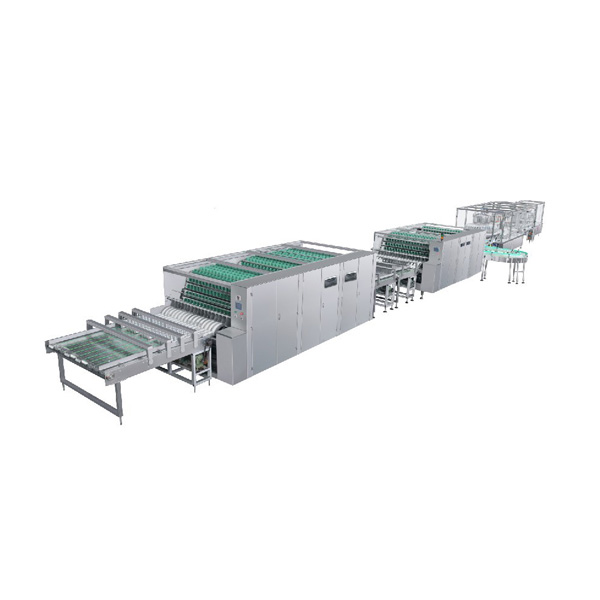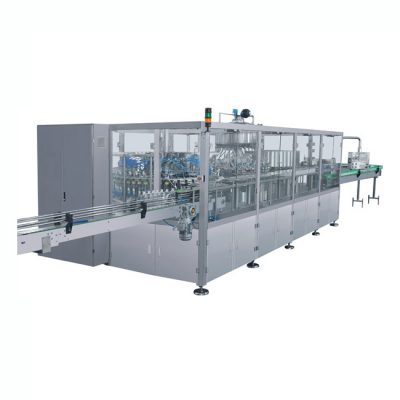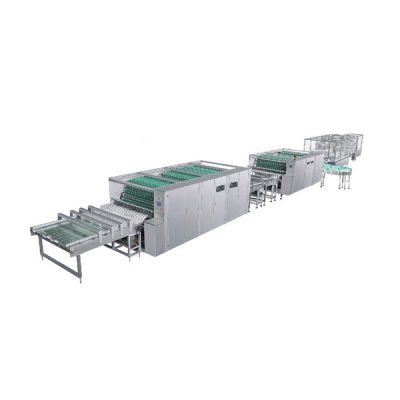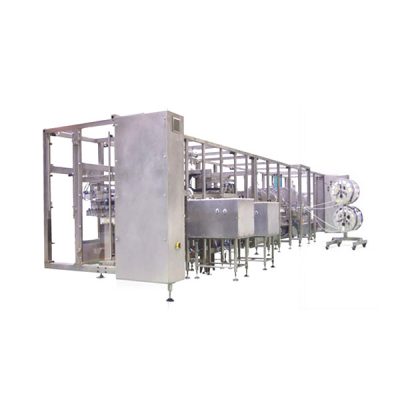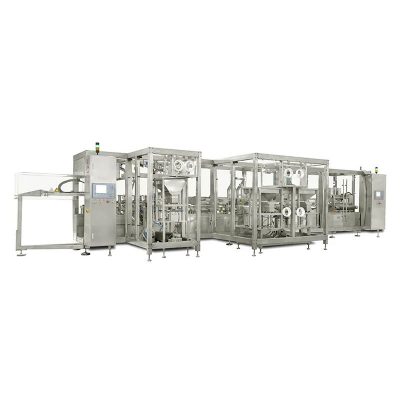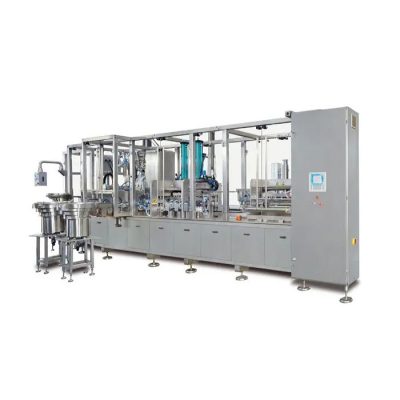Glass Bottle IV Solution Production Line
AIPAK Engineering glass bottle IV solution production line is composed of bottle unscrambler, rough washing machine, fine washing machine, filling and stoppering machine, capping machine. It can complete bottle unscrambling, rough washing, fine washing, nitrogen filling, vacuumize, stopper unscrambling, stopper pressing, cap unscrambling, capping and other complex functions, realizing automatic production of the whole process. Each machine can be used separately or in linkage line. The whole line is mainly used for production of sterile glass bottle IV infusions, and also final sterilized drugs.
Glass bottle example:

Glass Bottle IV Solution Production Line Features:
1.The corresponding part of the host is equipped with a buffer platform to ensure smooth operation at high speed.
2.The bottle washing machine adopts the patented technology of continuous bottle feeding and synchronous nozzle tracking washing, which is the first in the world. Under the same output, the volume of the machine can be reduced by one third, saving the use space; The water resource consumption is reduced by adopting the degraded recycling and reuse system; Patented quick card bottle holder, which reduces the time of installation and disassembly; The unique design of specification parts facilitates the replacement of specification parts; It can reduce the labor intensity of workers and reduce the use cost of equipment.
3.The patented technology of constant pressure continuous filling is adopted for filling, which has high filling accuracy and large production capacity, and realizes no filling without bottle, no pressure plug without bottle, in-situ cleaning and in-situ disinfection.
4.The capping machine adopts a unique capping technology, which solves the problem of unreliable capping during high-speed operation; Multi block inlay structure is adopted to solve the problem of replacement and use cost of easily worn parts.
5.The bottle loading and unloading machine adopts the patented technology of loading one layer at a time to make full use of the space of the sterilization trolley and improve the efficiency of the sterilization trolley.
6.The connection between the track and the track adopts staggered connection instead of docking, which solves the problem of bottle pouring caused by bottle stopping on the bridge slab.
7.The differential non resistance conveying platform makes the high-speed conveying system smoother.
Glass Bottle IV Solution Production Line Technical Specification:
| Certification Computerized | CE, GMP, ISO, SGS |
| Computerized | Computerized |
| Condition | New |
| Transport Package | Standard Export Package |
| Trademark | AIPAK Engineering |
| Production Capacity | 10000PCS/Month |
| Voltage | 220V |
| Customized | Customized |
| Warranty | 1 Year |
| Specification | Standard/Customized |
| Origin | China |
| Package size per unit product | 150.00cm* 150.00cm* 150.00cm |
| Gross welight per unit product | 150.000kg |
The Buyer's Guide
IV Fluids Glass Bottles Production Line: The Complete FAQ Guide In 2025
IV Fluid glass bottles are routinely used in the medical and healthcare industry. But have you ever wondered how they are filled? A state-of-the-art production line fills the IV fluid glass bottles.

IV Fluids Glass Bottles- Picture Courtesy: Proactive Investor
Manufacturers associated with the medical and healthcare industries are always striving to provide complete sterile IV solutions to customers. It is where the IV fluids glass bottle production line comes in handy. This production line is brought into this industry to perform different functions like washing, vacuuming, filling, sealing, capping, and other complicated jobs.
Are you in a hurry to set up an IV fluids glass bottles production line in your business? Then first take a step back and read carefully this FAQ guide to learn the different features and processes of this production line.
1.What is the IV Fluids Glass Bottles Production Line?
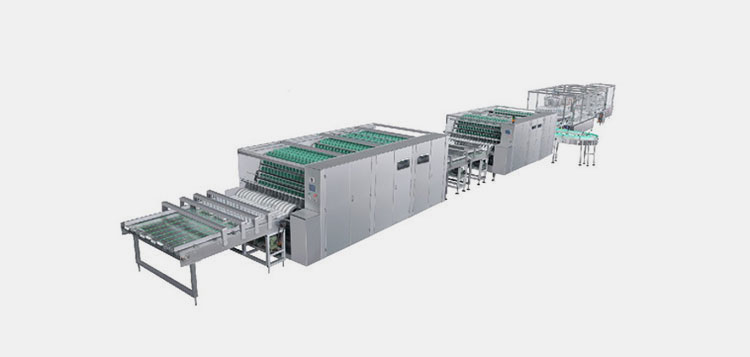
AIPAK Engineering IV Fluids Glass Bottles Production Line
An IV fluids glass bottles production line is defined as an interconnected set of machines that carry out different jobs involved in the packaging of IV fluid glass bottles.
These machines in the IV fluids glass bottles production line are arranged one after another and fill the IV fluids in the bottles made of glass. This production line packs the IV fluid solution in sterile bottles. These solutions are important in medical settings to provide patients with different drug medications and other nutrients.
An IV fluids glass bottles production line performs different steps like bottle feeding (unscrambling), washing, sterilization (vacuuming), filling IV solutions, and capping the bottles.
2.What are the Benefits of IV Fluids Glass Bottles Production Line?
IV fluids glass bottles production line is designed with the integration of automatic advanced technology that proves to be fruitful for the businesses. This production line is not only advantageous for the manufacturers but also for the customers and the environment. Some useful benefits of this production line are penned below for your understanding.
Increased Production Efficiency

High Protection Efficiency of IV Fluids Glass Bottles Production Line
IV fluids glass bottles production line consists of high-tech automation and up-to-date equipment that execute different steps in a timely fashion. This decreases the production time and packs more IV fluids glass bottles speedily. This increases the production efficiency.
High-Cost Effectivity
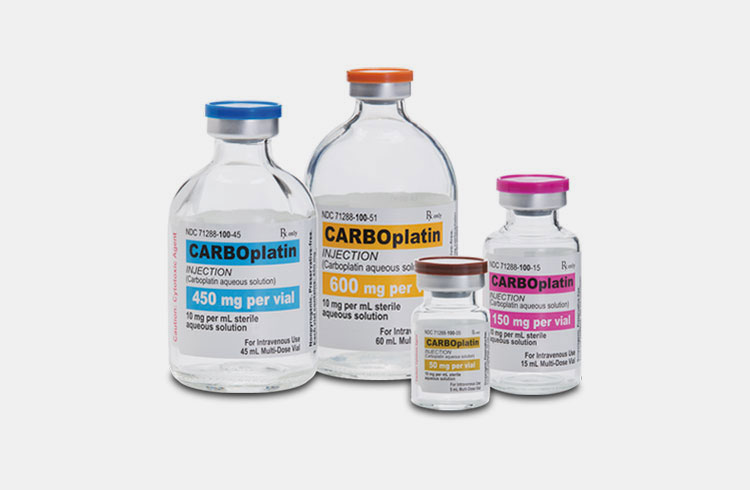
Cost-effectiveness of IV Fluids Glass Bottles Production Line- Picture Courtesy: EMEDZ.NET
Yes, the IV fluids glass bottles production line is a cost-effective solution because of its speedy production. Even though the purchasing cost of this equipment is quite high, in the long run, it generates more profits by its accurate and top-notch packaging. It does not waste any IV fluid solution and breaks glass bottles, saving money and bringing profits.
Increased Patient Safety
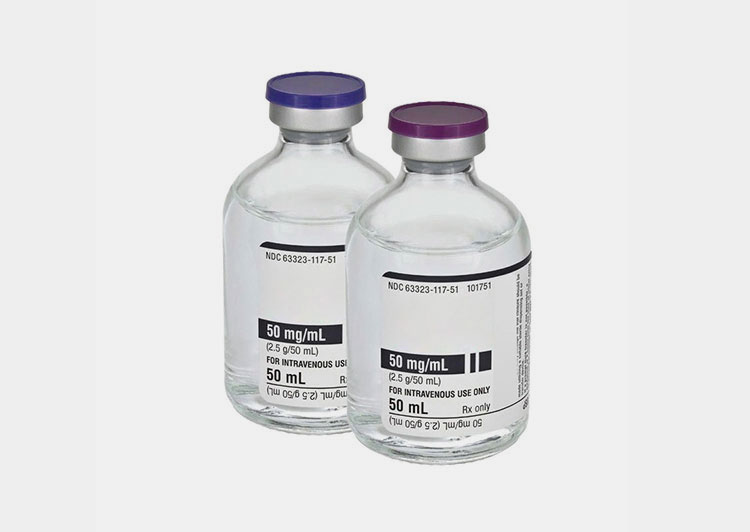
Increased Patient Safety by IV Fluids Glass Bottles Production Line- Picture Courtesy: Iven-pharma
The IV fluids glass bottles production line has an immense role in patient safety. This is because glass is an inert material and does not react with the inner IV fluid solutions. This maintains the sterility of the IV fluids and does not compromise patient safety. The IV fluids glass bottles production line is designed by taking into account strict safety regulations.
Durability and Protection of IV Fluid Solution

Durability of IV Fluids Glass Bottles Production Line- Picture Courtesy: Iven-pharma
This production line packs solutions in protective glass materials. These glass bottles are strong barriers and are resistant to moisture, oxygen, and other contaminants. Moreover, these glass bottles are tough and robust, offering a secure environment to IV solutions and do not allow them to leak.
100% Sustainability
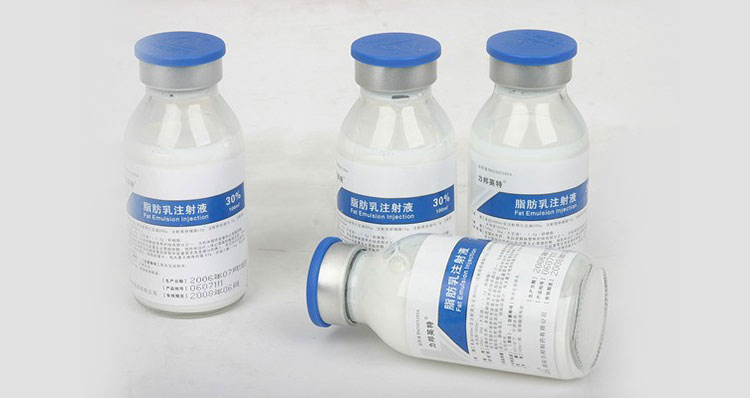
Sustainability of IV Fluids Glass Bottles Production Line- Picture Courtesy: YK Machinery
An IV fluids glass bottles production line is 100% sustainable and eco-friendly because it fills IV fluids solution in the glass bottles that are easily recycled and used again and again without losing their integrity and purity. Moreover, glass bottles do not emit toxic compounds in the environment, making this production line an environment-friendly solution.
3.How Does the IV Fluids Glass Bottles Production Line Work?
An IV fluids glass bottles production line is a huge setup, having different machines for performing different steps. The working of this production line is completely harmonious and continuous in which each step occurs with great precision. A detailed discussion of each step is accounted for below:
Bottle Unscrambling

Bottle Unscrambling- Picture Courtesy: machine-pharma.com
First, empty bottles are put on the conveyor of IV fluids glass bottles production line by the bottle unscrambling machine. This machine sequentially places bottles on the conveyor. These bottles travel to the washing area.
Bottle Washing
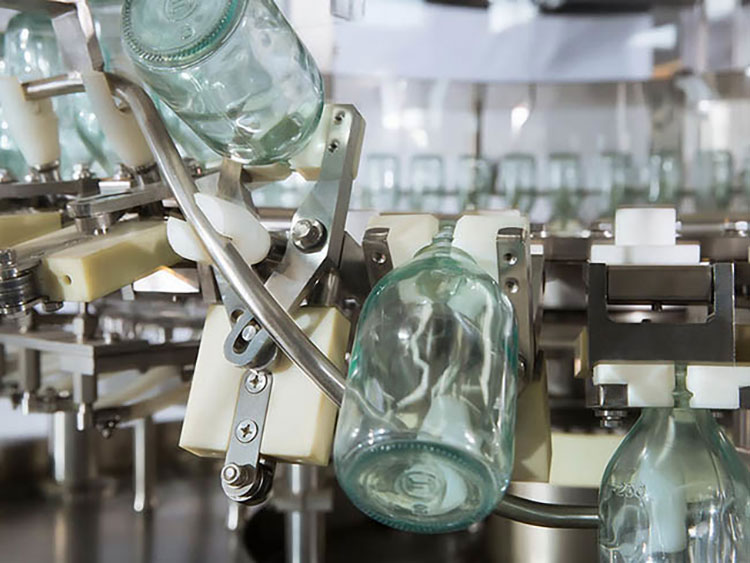
Bottle Washing- Picture Courtesy: Iven-pharma
These bottles move to the washing turn table and in the bottle washing machine, purified clean water is injected into the bottles to remove debris and other dust particles. Injection needles wash the bottles with water. Secondly, compressed air is blown by another set of needles to wash the bottles. The compressed air also dries the outer walls of bottles.
Bottle Sterilization
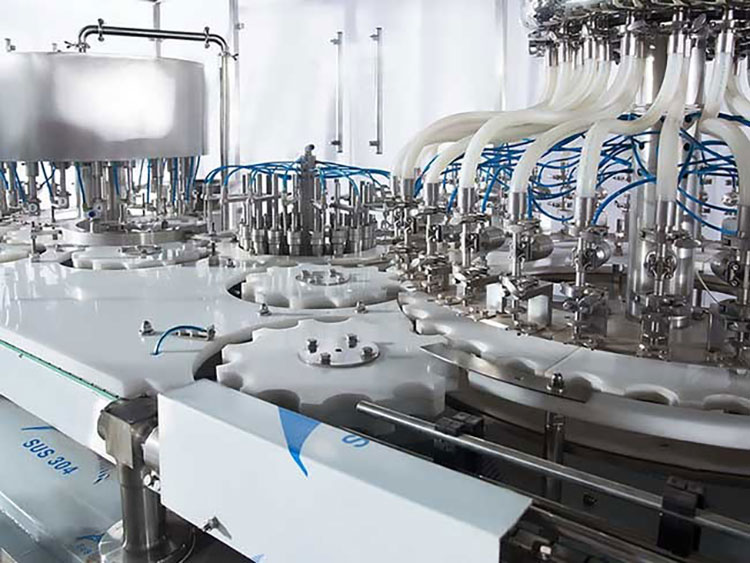
Glass Bottle Sterilization- Picture Courtesy: Iven-pharma
Bottles are sterilized using heat, steam, or other chemical methods. A Laminar flow tunnel is also used for dry sterilization of the bottles. This sterilization is effective in removing the microbes from the bottles.
Filling

Bottle Filling- Picture Courtesy: Iven-pharma
In this step, different filling techniques are applied to precisely dispense the IV fluid solutions in the glass bottles. Different sensors and filling devices load the IV solutions into glass bottles without any trace of error.
Vacuuming and Nitrogen Charging
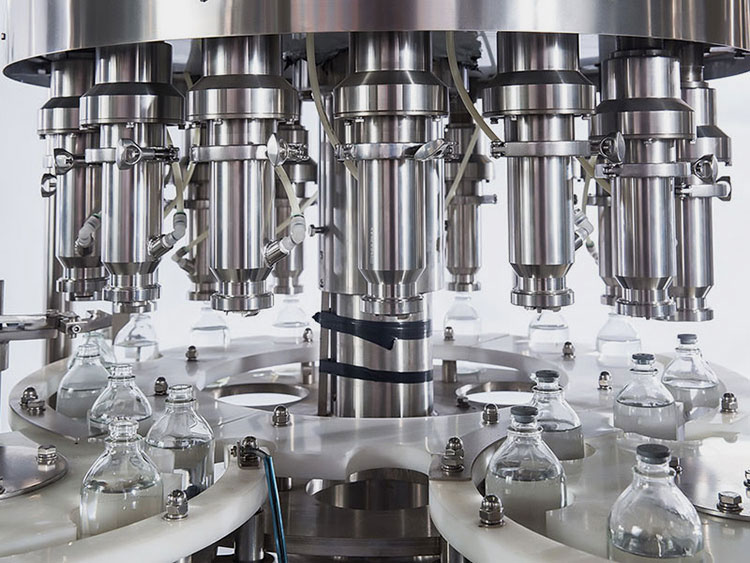
Bottle Vacuuming- Picture Courtesy: machine-pharma.com
This step is carried out to ensure nitrogen protection in the filled glass bottles. In this step, the IV fluids glass bottle is vacuumed and nitrogen is fed inside the bottles when the preset level of vacuum is reached. This step is carried out to eliminate oxygen from the headspace of the bottles.
Stopping, Capping, Labeling

Bottle Stopping and Capping- Picture Courtesy: Iven-pharma
At this step, the bottles are sealed and crimped using a bottle capping machine. It picks up the cap and crimps it while rolling it simultaneously. This step is essential in increasing the aesthetic appeal of glass bottles. After capping, the IV fluids glass bottles are moved to the labeling area where information is printed on the bottles.
Bottle Discharging
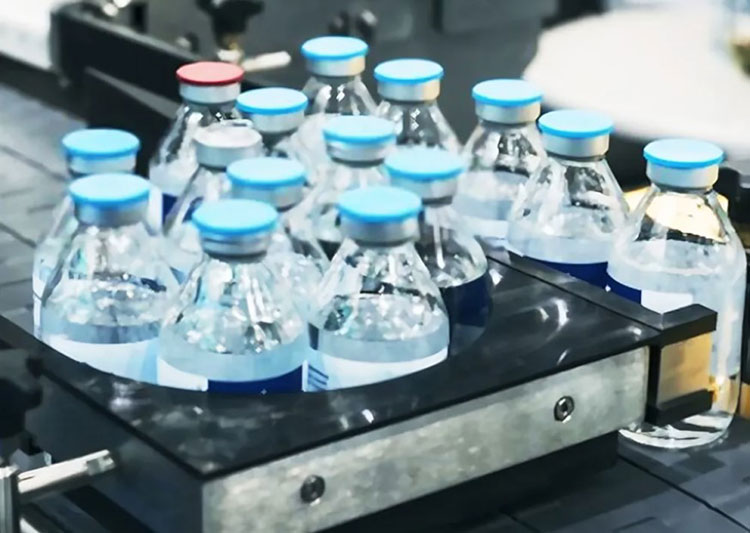
Discharging of Glass Bottles- Picture Courtesy: Iven-pharma
After capping and subsequent labeling, the IV fluids glass bottles are discharged from the production line and are carried out to other inspecting processes.
4.What Filling Types are Performed in the IV Fluids Glass Bottles Production Line?
In the IV fluids glass bottles production line, different types of filling are performed to load glass bottles. These filling types are discussed one by one below:
Gravity Filling

Gravity Filling- Picture Courtesy: ALiEM
In this type of filling, the gravitational force is utilized for filling the glass bottles. The bottles are placed under the hopper and fluid is fed into the glass bottles by gravitational stimuli. It is used for filling low-viscosity or thinner IV fluids in glass bottles.
Piston Cylinder Filling
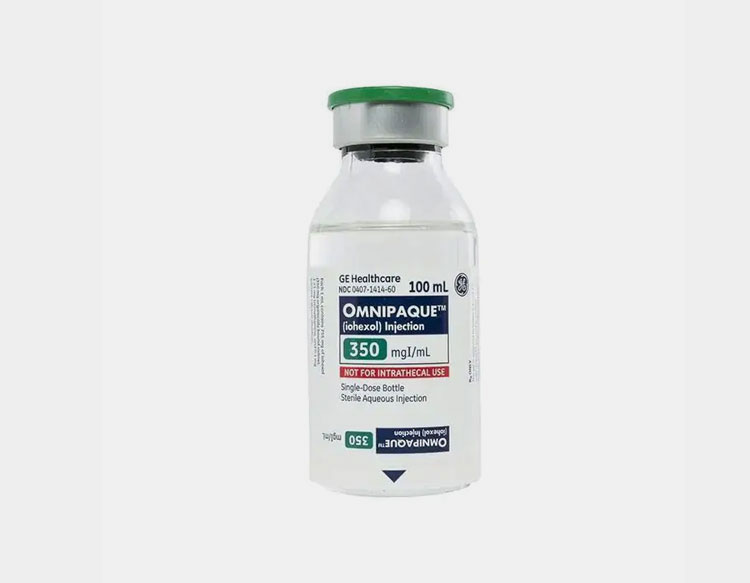
Piston Filling- Picture Courtesy: Dwatson
It is the type of volumetric filling that involves the movement of the piston in the cylinder to fill predetermined quantities of IV fluids in glass bottles. It is employed for IV fluids with constant viscosity.
Peristaltic Pump Filling
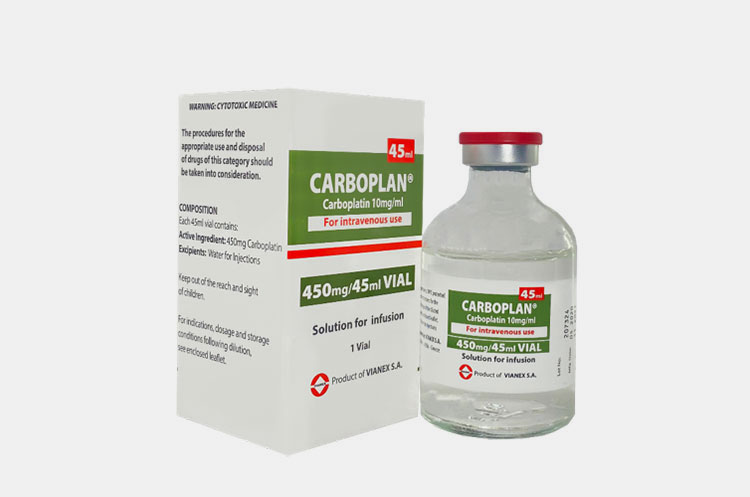
Peristaltic Pumps Filling- Picture Courtesy: alhilalds.com
By the rotation of peristaltic pumps, the flexible tube is compressed, forming a vacuum in the hose pipes. This vacuum is essential in pushing liquids into hose pipes and glass bottles. It is frequently used for filling IV fluids because of its contamination-free filling.
Vacuum Filling
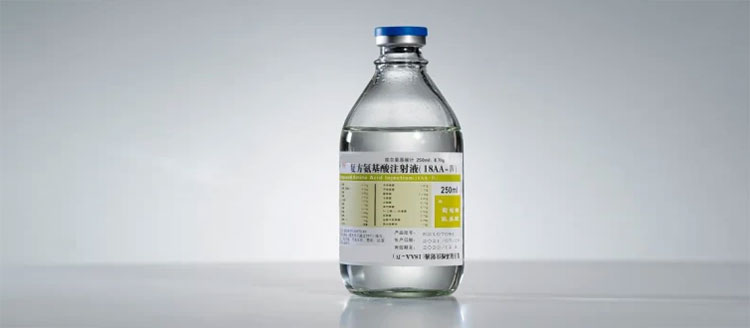
Vacuum Filling
In this filling process, a vacuum is formed in the glass bottles for the filling of IV fluids. Vacuum discharges the air from the glass bottles and fills them with IV fluids. This filling method is well-suited for filling viscous IV solutions.
5.What Solutions are Filled by the IV Fluids Glass Bottles Production Line?
An IV fluids glass bottle production line fills a vast range of IV solutions in the glass bottles. These solutions are used for medical remedies. These solutions are delivered intravenously to different patient groups. Some examples of solutions filled by this production line are written below:
| Saline Solution
It is also called a saltwater solution and contains different concentrations of sodium chloride. It is used for treating medical emergencies like shock and dehydration. |

Saline Solution- Picture Courtesy: Homoempatia |
| Glucose Solution
This solution is formed by dissolving glucose in the water. It is used for providing instant energy to the body and for treating low blood sugar levels. |
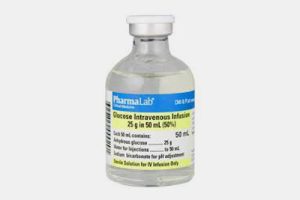
Glucose Solution- Picture Courtesy: Medical and Surgical Requisites |
| Electrolyte Solution
It is also called Ringer solution and it has the same concentration of electrolytes as found in the body. It is used for treating burns and dehydration. |
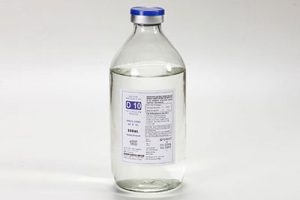
Electrolyte Solution- Picture Courtesy: Albert David Limited - Manufacturing Pharmaceutical Formulations |
| Lactate Ringer Solution
This solution has electrolytes in the exact concentration as found in the Ringer solution. However, it also contains lactate. This solution is used in fluid replacement treatment. It is given to patients with metabolic acidosis. |
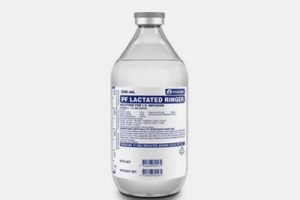
Lactate Ringe Solution- Picture Courtesy: Polifarma |
| Amino Acids Solution
This solution has different concentrations of amino acids and is used for curing nutritional deficiencies in patients who cannot ingest food orally. |

Amino Acid Solution- Picture Courtesy: EntirelyPets Pharmacy |
| Fat Emulsion Solution
It is a part of total parenteral nutrition. It is also called lipid emulsions and is prepared by dispersing fats in water. It is administered in patients who are suffering from essential fatty acid deficiency. |
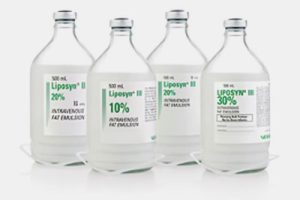
Fat Emulsion Solution- Picture Courtesy: McGuff |
| Antibiotic Solution
This solution is prepared by dissolving different antibiotics like Levofloxacin and Ciprofloxacin in the saline solution. These solutions are used for treating bacterial infections intravenously. |
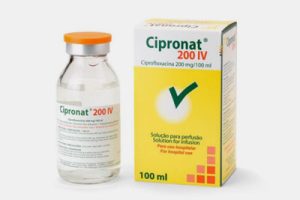
Antibiotic Solution- Picture Courtesy: Dafra Pharma |
| Chemotherapy Solution
Some IV fluids glass bottles are also filled with the chemotherapy agents that are used for treating cancer patients. These agents kill cancer cells and stop their growth. |
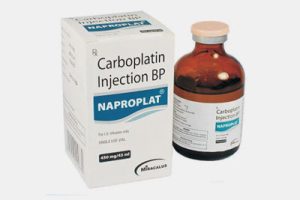
Chemotherapy Solution |
6.What Volumes and Sizes of Glass Bottles are Filled by the IV Fluids Glass Bottles Production Line?
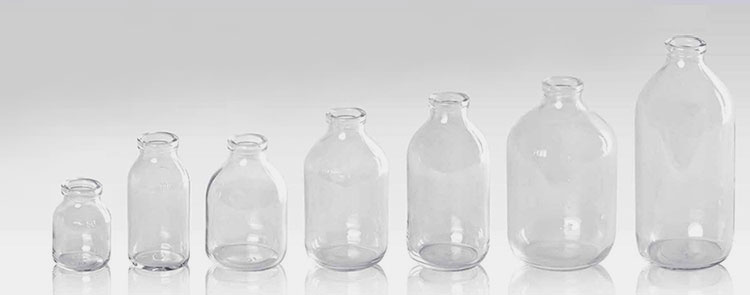
Volumes and Sizes of Glass Bottles are Filled by IV Fluids Glass Bottles Production Line- Picture Courtesy: mpbottle.com
Miscellaneous assortment of volumes and sizes of glass bottles processed by the IV fluids glass bottle production line. These glass bottles vary both in size and volume. The smallest volume of IV fluids filled in glass bottles is about 50 ml while the largest volume filled in glass bottles in this production line is about 500 ml.
The size of the glass bottle processed by this IV fluids glass bottle production line is in the range of 60 to 177 mm. The volumes and sizes of glass bottles filled by this production line are discussed below in the table:
| Volume of Glass Bottle (ml) | Weight (g) | Length (mm) | Diameter (mm) |
| 50 | 65 | 68 | 48 |
| 100 | 100 | 104 | 49 |
| 150 | 136 | 102.5 | 66 |
| 250 | 145 | 125 | 68 |
| 250 | 175 | 136 | 66 |
| 500 | 220 | 147 | 86 |
| 500 | 250 | 177 | 78 |
7.What Kinds of Stopping and Closures Is Used on Glass Bottles by IV Fluids Glass Bottles Production Line?
The IV fluids glass bottles production line places different kinds of crimps, stoppers, and closures on the glass bottles to ascertain the safety and integrity of IV fluid solutions. Let’s explore all these kinds of caps and stoppers.
Rubber Stopper
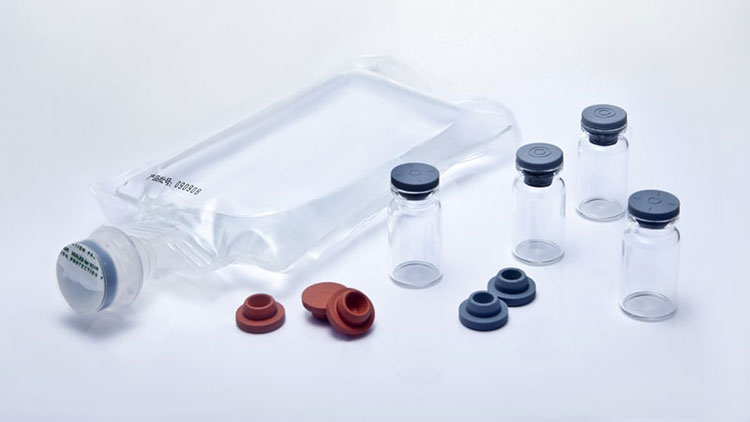
Rubber Stopper- Picture Courtesy: shengzou.com
These closure types are widely popular for their use in the IV fluids glass bottles production line. They have superior sealing characteristics and are well-suited to different IV fluids. As the name suggests, these are made with synthetic rubber such as bromobutyl or chlorobutyl rubber. These rubbers do not react with the chemicals and have impermeability to different environmental gases.
Silicon Stopper
![]()
Silicon Stopper- Picture Courtesy: vialbottle.com
It is also used most frequently with IV fluids in glass bottles. These stoppers are made with silicon which is known for its chemical nonreactivity. Silicon stoppers also can withstand high temperatures. These stoppers are used when IV fluids glass bottles are needed to autoclave.
Aluminum Seals
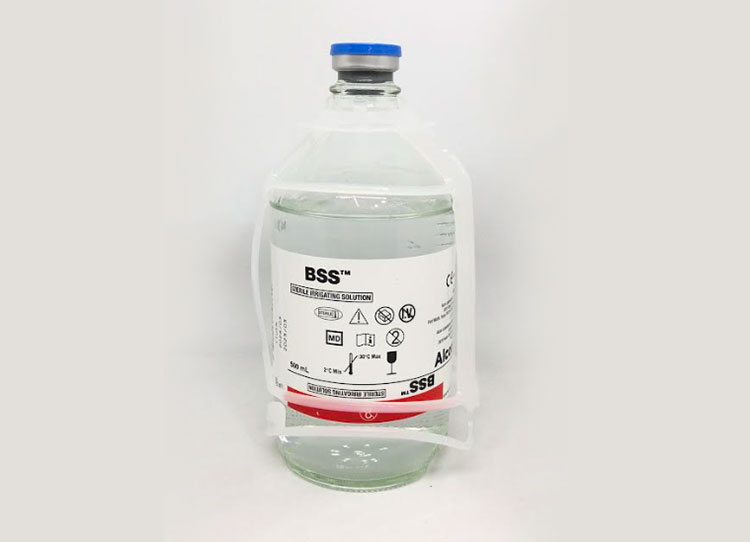
Aluminum Seals- Picture Courtesy: David Jone Pharmacy
These seals are used with silicon and rubber stoppers for added protection and security of IV fluids. The necks of the bottles are crimped with aluminum seals. These seals are fixed in place and are tamper-proof.
Flip-off Caps
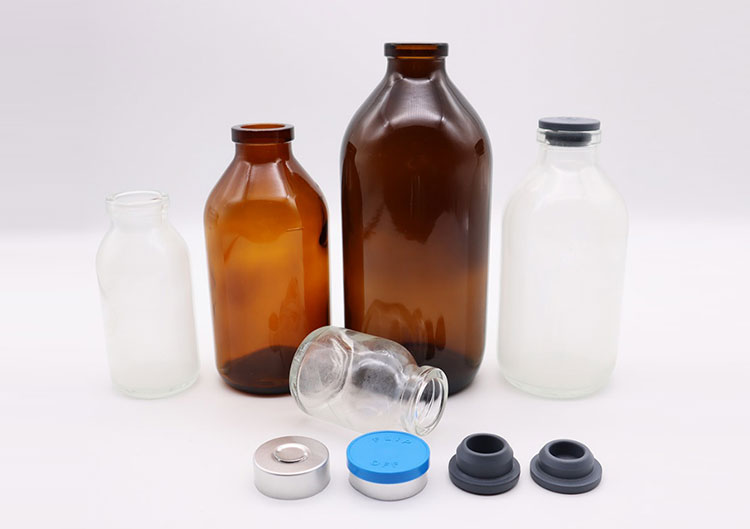
Flip Top Caps
These include aluminum seals and plastic layers. This plastic layer is taken off by flipping off to reveal a hidden stopper. This stopper is punched to administer IV fluids. This type of stopper construction provides an added layer of sterility and also shows if the glass bottles are tampered with.
Euro Caps

Euro Caps
These caps are made of plastic and have an aluminum seal underneath. These provide easy opening and convenient access by removing the complete cap assemblage.
8.What Information IV Fluids Glass Bottles Production Line Print On IV Fluids Bottles?
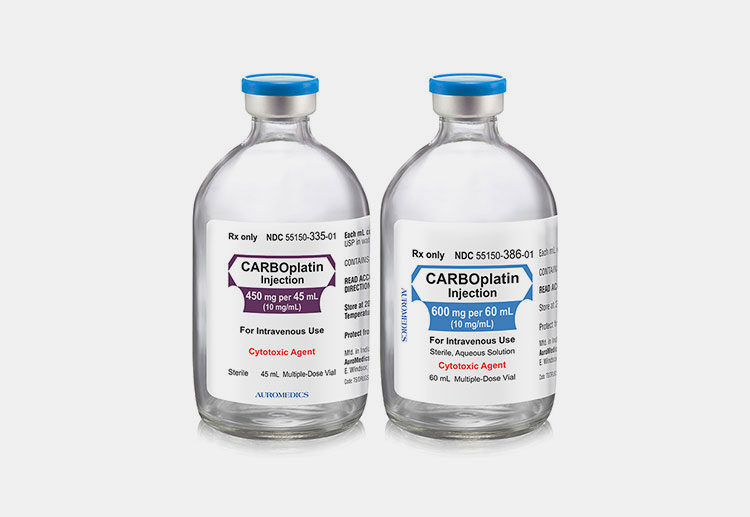
Labeling on IV Fluids Glass Bottles
There must be particular information labeled on the IV fluids glass bottles to ensure accurate and safe usage of IV fluids. Therefore, IV fluids glass bottles production lines must print and label certain information to inform the workforce and patients about the safe utility of IV fluids. This information includes:
| Product Name | First and foremost, the IV fluids glass bottle production line mentions the product name (composition of fluid) in the prominent font on the center of the label. |
| Ingredients | It also mentions this list of ingredients and their concentration present in the IV fluids. Ingredients can include saline, electrolytes, glucose, nutrients, and other medications. |
| Volume | The net volume of the IV fluids is also labeled on the glass bottles. The volume of the IV fluids is in milliliters or liters. |
| Solution Type | IV fluid solution type like hypertonicity, isotonicity, and hypotonicity is also included on the label. |
| Batch Number | The batch identification number which is the number of batches from which IV fluids glass bottle is produced is also written on the label. |
| Expiration Date | It is the most important information marked on the label. It indicates the date after which solutions must not be used for the safety of the patient. |
| Storage Conditions and Usage Information | The instruction about properly storing the IV fluids in glass bottles is mentioned on the label. Also, usage instructions like allergen warnings and the proper utility of these bottles are included on the label. |
| Bar Code | Tracking and tracing numbers for IV fluids glass bottles are also incorporated on the label. |
| Sterility Information | The method used for sterilizing the bottles is also written on the labels. |
| Regulatory Compliance | Different marks indicating regulatory compliance like CE, FDA, and ISO are also symbolized on the label of IV fluids glass bottles. |
| Manufacturer Information | Last but not least, manufacturer information like name, address, and website is also printed on the label. |
9.How Does IV Fluids Glass Bottles Production Line Ensure The Sterility Of IV Fluids?
There are different ways by which IV fluids glass bottle production line maintains the sterility of IV fluids such as:
Clean Working Room

Clean Working Room of IV Fluids Glass Bottle Production Line- Picture Courtesy: Iven-pharma
Different packaging processes including the filling and capping are done in the sterile room. A clean environment reduces the chances of airborne particle contamination.
Sterilization of Parts and Machine

Sterilization of Parts in IV Fluids Glass Bottle Production Line- Picture Courtesy: Syntegon
Different techniques by irradiations, heat, chemicals, and autoclaving are utilized to sterilize different caps, glass bottles, tubing, and machines like filling and capping machines. These techniques kill microbes and prevent their growth and development.
Aseptic Processes
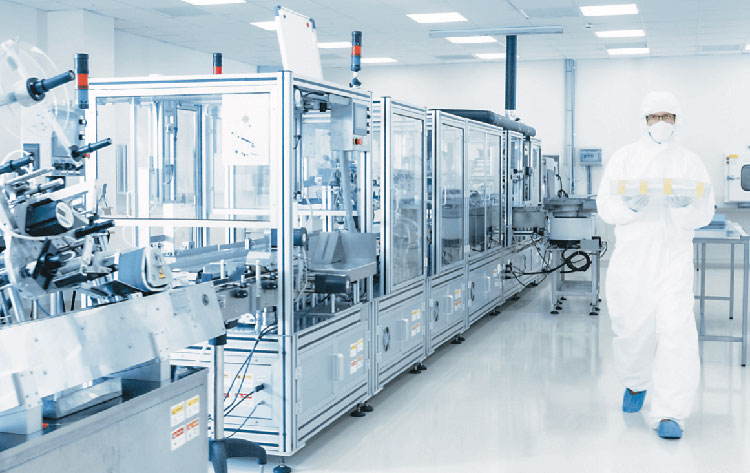
Aseptic Processes in IV Fluids Glass Bottle Production Line- Picture Courtesy: A3P
Operators and the workforce supervising the IV fluids glass bottle production line must follow strict aseptic practices to ensure sterility in the working environment. They must wear PPE (gloves, overall and closed shoes) and must utilize sterile tools to handle IV fluids.
Barrier Systems

Barrier Systems in IV Fluids Glass Bottle Production Line- Picture Courtesy: Syntegon
This production line uses different barrier systems like laminar airflow hoods to form a physical separation between packaging operation and surroundings. This prevents the entry of contaminants and microbes in the IV fluids glass bottles from the surrounding environment.
10.What Are The Quality Control Tests Adopted By IV Fluids Glass Bottles Production Line?

The Quality Control Tests Adopted By IV Fluids Glass Bottles Production Line
The IV fluids glass bottles production line must carry out different quality control tests to ensure stringent safety measures. These quality tests for IV fluids glass bottles include:
| Glass Quality Test | Thorough testing is carried out to check the scratches, breaks, or cracks on the glass bottles. Technicians also observe the clarity, dimensional differences, and imperfections of the glass bottles. |
| Glass Composition Test | Different automated machines are used to check the standard composition of glass bottles. These machines also measure the chemical inertness and compatibility of glass with the IV solutions. |
| Closure Inspection Test | Different tests are performed on the closures to observe their seal effectivity and their prevention of leakage. These tests also check the compatibility between IV fluids and stoppers. |
| Leakage Detection Test | After filling, different machines check for leakage in the glass bottles. The leaking bottles are then rejected from the production line. |
| Fill Volume Test | The exact volume of the glass bottles is verified through different means. This volume should be the same as specified on the labels. This is important for dose accuracy. |
| Visual Inspection Test | After filling, the glass bottles are methodically checked for cloudiness, particulate materials, and product labeling. If bottles have a presence of foreign objects, they are rejected. |
| Sterility Tests | Samples from batches are taken in these tests and cultivated to prove the nonexistence of different microbes in the IV fluids glass bottles. |
11.What are the Challenges and Solutions of the IV Fluids Glass Bottles Production Line?
Challenges and problems arise when setting up an IV fluids glass bottles production line in the production plant. However, these challenges are easily resolved by following some basic tips. Let’s learn about the challenges and solutions of the IV fluids glass bottles production line.
Sterility Requirement in Production
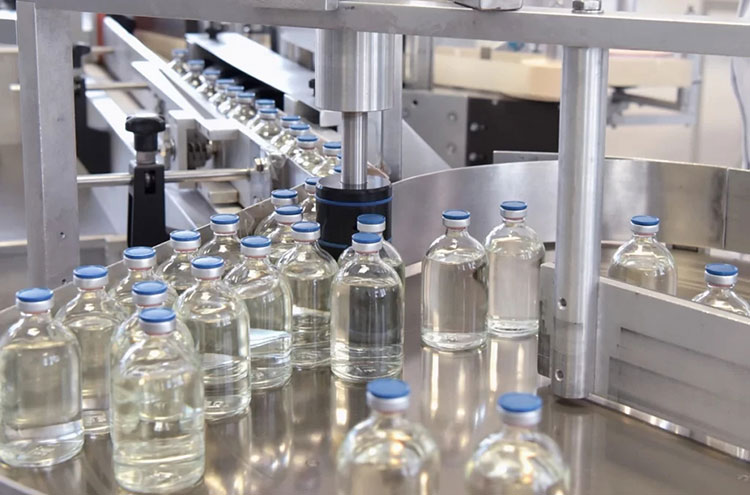
Sterility Requirement in IV Fluids Glass Bottle Production Line- Picture Courtesy: Iven-pharma
It is crucial to maintain sterility in the production because microbial or dust contamination can cause serious health adverse reactions in the patients.
Solution
Opting for up-to-date and sophisticated techniques like autoclaving, and irradiation properly maintains the sterility in the production. These techniques sterile every surface and aim to prevent contamination risk.
Accuracy in the Filling Solutions
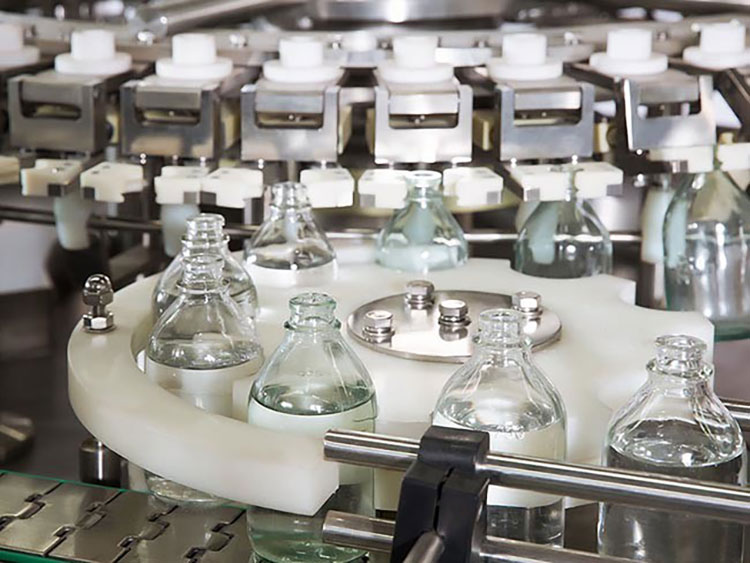
Fill Accuracy in IV Fluids Glass Bottle Production Line- Picture Courtesy: Iven-pharma
Maintaining fill accuracy of the IV fluids in the glass bottles is essential because variation in volume could cause over and under-filling. This impacts the dosage accuracy and safety of patients.
Solution
Utilizing automatic filling systems can ensure dosing accuracy. These fillers have sensitive volume-checking systems that increase fill efficiency.
Breakage of Glass Bottles

Breakage of Glass Bottles in IV Fluids Glass Bottle Production Line- Picture Courtesy: machine-pharma.com
Glass bottles may break or crack during product filling and other processes. This decreases the quality and safety of IV fluids, leading to product wastage and contamination.
Solution
Breakage of glass bottles may be prevented by utilizing state-of-the-art handling systems. These systems delicately handle glass bottles, ensuring their protection.
Cleaning of Glass Bottles
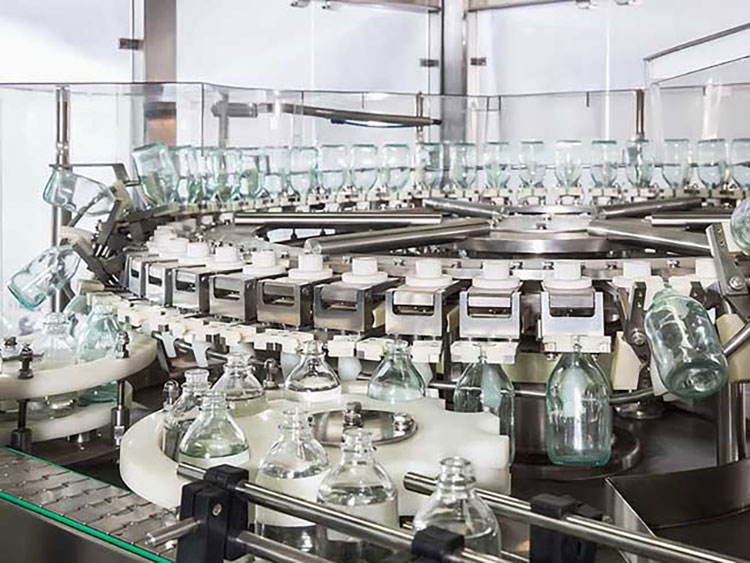
Cleaning of Glass Bottles in IV Fluids Glass Bottle Production Line- Picture Courtesy: machine-pharma.com
Glass bottles are difficult to clean and usually require large amounts of water for their cleaning. This negatively impacts the environment and reduces the eco-friendliness of the IV fluids glass bottles production line.
Solution
This challenge of sustainability is resolved by implementing energy energy-efficient cleaning processes. Morden cleaning technologies efficiently clean glass bottles without consuming much water.
Conclusion
The IV fluids glass bottles production line is a crucial part of the medical and pharmaceutical sector. It consists of state-of-the-art types of machinery that are highly sought after nowadays, because of their advanced quality manufacturing processes and thorough commitment to patient safety. This production line is a highly specialized unit and it adheres to all the necessary regulatory standards to ensure the safety and accuracy of medication and dosage. The accuracy, precision, cost-effectiveness, and sustainability of the IV fluids glass bottles production line make this production line the best among all. For purchase details and more queries regarding the IV fluids glass bottles production line, please visit the AIPAK Engineering website.
CONTACT US
Tell us your raw material and project budget to get quotations within 24 hours.
WhatsApp:+86 18171018586
 Tell us your material or budget, we'll reply you ASAP within 24 hours
Tell us your material or budget, we'll reply you ASAP within 24 hours
Glass Bottle IV Solution Production Line Related Products

